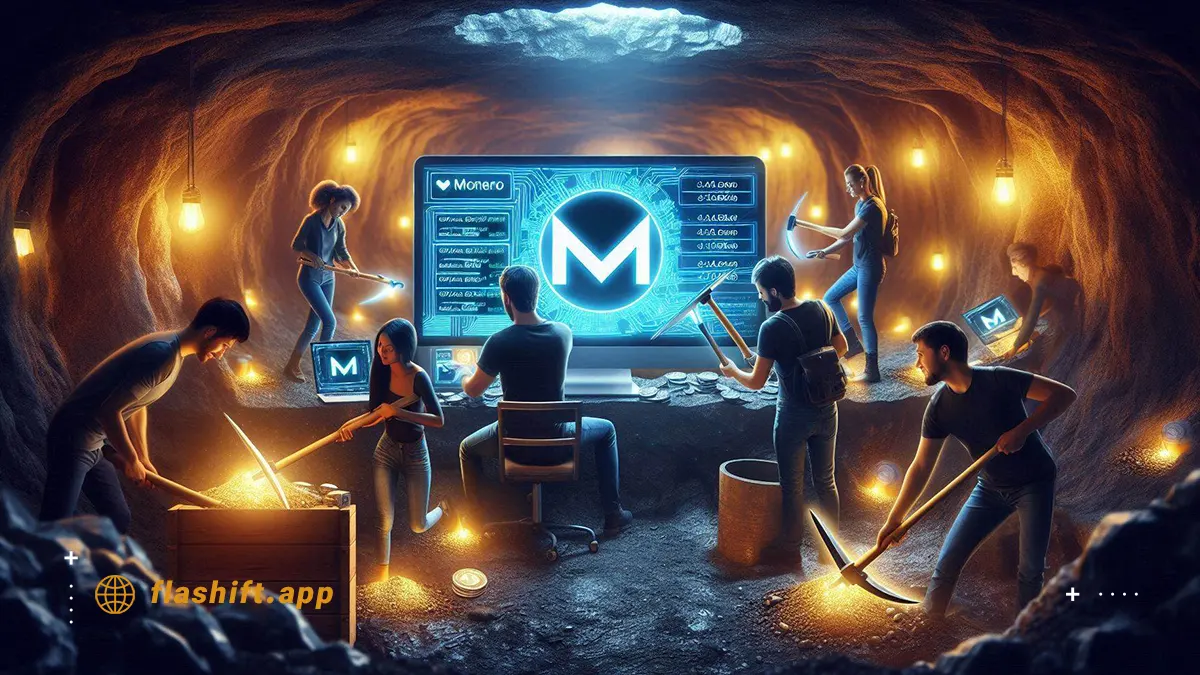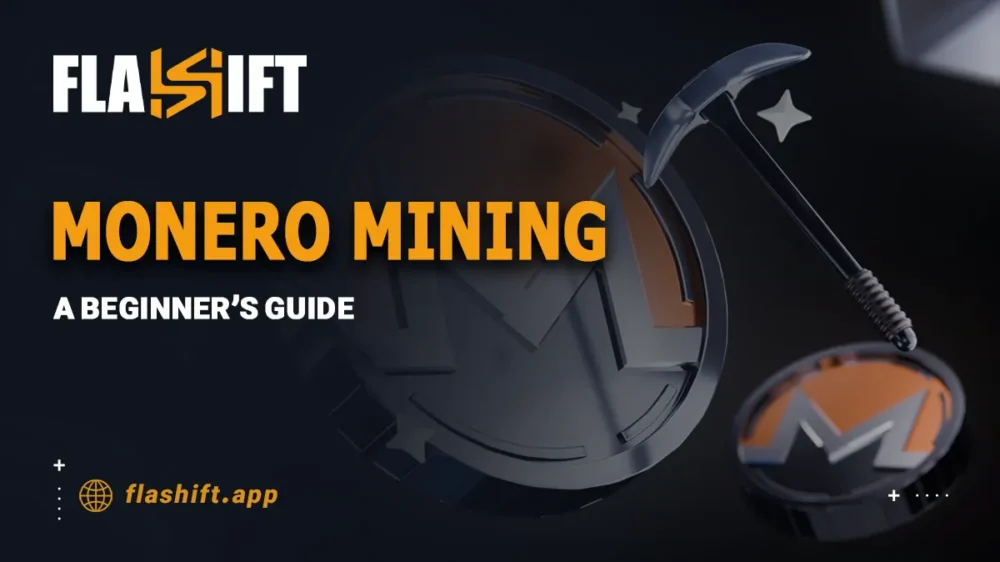Monero Mining | In the dynamically changing world of cryptocurrencies, Monero is still in the top position because of its attitude towards privacy and anonymity. With growing users’ desire to secure their transactions and store value, interest in mining Monero has increased. This Monero mining tutorial explains in detail the mining process and the hardware preparation for it, as well as a few more tips on maximizing your efforts.
Unlike Bitcoin, which requires specialist hardware and is incredibly centralized, Monero’s mining algorithm is optimized for CPU mining. Because of this, it is vastly more accessible to casual individuals looking to gamble at mining cryptocurrency or who are simply interested in the features of Monero, with its primary focus on privacy. This paper aims to inform the reader how to mine Monero safely and effectively. Join us as we delve into the details of Monero mining and discover how you can join this revolutionary network and keep your transactions private.
Introduction to Monero Mining: Why Choose Monero?
Thus, within the ever-expanding realm of cryptocurrency, a quest for security and private transactions has turned many users to Monero, better known as XMR, for use as an investment and mining. Unlike mainstream cryptocurrencies, such as Bitcoin, Monero has been engineered with the foremost intent of user privacy and anonymity. This makes cryptocurrency attractive for users who want confidentiality in their financial dealings.

One of the most valid reasons to mine Monero is its strong privacy features. Using advanced cryptographic techniques, Monero ensures that all transactions are private, keeping the sender and receiver information and the amounts transferred under wraps. This dedication to privacy attracted a committed group of ambassadors who appreciate staying anonymous in one’s financial dealings.
Another factor differentiating Monero from any other cryptocurrency is its mining, which is available to anyone. That is because the RandomX algorithm of Monero was designed with a CPU in mind, not expensive ASIC machines. It democratizes mining by allowing people to participate without significant financial investment. This Monero mining tutorial will give you hands-on advice on setting up and optimizing performance and joining the general Monero community. Whether you are a seasoned miner or an inquisitive beginner, you will learn why Monero stands apart for those who are into mining privacy-enabled cryptocurrency.
RandomX Mining Algorithm: Why It’s Built for Monero
Monero has popularized impressive privacy features and an innovative mining algorithm called RandomX. Introduced in November 2019, RandomX was explicitly designed to promote better decentralization and security on the Monero network while making its mining more open to a broad audience. This article will closely examine the distinctive features of the RandomX mining algorithm and how well it aligns with core principles: privacy and user empowerment.
Accessibility and Decentralization
One of the key drivers behind the RandomX algorithm was democratizing the mining process. While Bitcoin today requires ASICs, necessitating a tremendous financial investment and technical know-how, RandomX is optimized for CPU mining. In other words, anyone can mine Monero using commodity hardware like laptops and desktop computers. RandomX reduces the barrier to entry for miners; hence, it makes the network more decentralized since ASIC mining is less centralized. A decentralized network is crucial for Monero to ensure better security and robustness regarding attacks and collusion.
Improved Security and Resistance to Manipulation
RandomX features a unique proof-of-work algorithm that strengthens the overall security attributes of the Monero network. The RandomX algorithm has been designed to be highly memory-hard, demanding significant amounts of RAM for efficient mining. Due to this attribute, it becomes challenging to devise specialized hardware ASICs that outperform regular CPUs and can result in network centralization easily. Moreover, randomness within the algorithm prevents miners’ pre-computation of data or optimizations, which would give them undue advantages. This philosophy aligns with Monero’s commitment to privacy and equality, where all miners are afforded equal opportunity to contribute to the network.
Enhanced Privacy Features
While RandomX’s primary focus is on improving the accessibility and decentralization of mining, it also complements Monero’s greater ambitions in terms of privacy. The mining algorithm is entirely separate from the transaction detail requirements on the Monero blockchain; therefore, mining does not affect user privacy. The inherent features of Monero that guarantee privacy, such as ring signatures and stealth addresses, are not affected by the form in which this cryptocurrency is mined. Hence, users can conduct their activities without the threat of their financial exposure. By wrapping RandomX inside of it, Monero ensures that the network stays safe and private, joining the right mind in this cryptocurrency.
Conclusion
The RandomX mining algorithm has been one factor in Monero’s core, and further development in this regard helps this cryptocurrency work on aspects like decentralization, security, and privacy. By allowing users to mine with standard CPUs and impeding the growth of ASICs, RandomX democratizes the mining process, thus fortifying the network against centralization. Such a unique approach perfectly fits the core mission of Monero: providing a private and secure cryptocurrency for all its users. The algorithm RandomX will be paramount to keep Monero competitive in the future as one of the leading cryptocurrencies with features focused on privacy while evolving and growing.
Read More: Privacy Coins Benefits, Risks, and the Regulatory Outlook for 2024
Step-by-Step Guide to Mining Monero for Beginners
Mining Monero is an excellent opportunity to engage in this exciting cryptocurrency environment that seems to orient its focus on privacy, probably with several rewards. With its friendly mining algorithm, RandomX, Monero is within reach of beginners who want to try mining using typical computer hardware. In addition, a step-by-step guide will walk you through the basics of setting up your Monero mining, from preparation to firing up your first mining session.

Step 1: Understand the Requirements
You would have to know, before you begin mining, what is required to be able to do it. You will need:
- Hardware: A computer with a modern CPU. While you can mine with a laptop, a desktop with a powerful processor will yield better results. GPUs are also an option, but for beginners, CPU mining is much easier to access.
- Operating System: Its mining software is compatible with Windows, macOS, and Linux.
- Internet Connection: The mining process requires a connection to the Internet; hence, it needs a stable Internet connection to connect it to a mining pool.
Step 2: Choose a Mining Pool
It is not that easy to mine Monero solo, especially for beginners. In joining a mining pool, one is assured of better chances of earning rewards because one is combining their hash rate to compete with other miners. Following are some of the popular mining pools for Monero:
- MineXMR
- SupportXMR
- MoneroOcean
You can research different pools to find one that suits your needs regarding fees, payout structure, and server locations. Once you choose a pool, please sign up and create an account if necessary.
Step 3: Download and Install Mining Software
Next, you need to choose mining software compatible with the RandomX algorithm. Some popular options for Monero mining include:
- XMRig: A widely used and customizable mining software that supports CPU and GPU mining.
- XMR-Stak: This option is excellent for beginners and offers a user-friendly interface.
Here’s how to download and set up XMRig as an example:
- Visit the official XMRig GitHub repository: [XMRig GitHub] (https://github.com/xmrig/xmrig).
- Download the appropriate version for your operating system.
- Extract the downloaded files to a folder on your computer.
Step 4: Configure the Mining Software
Now that you have the mining software, you must configure it to connect to your chosen mining pool. Here’s an essential guide to configuring XMRig:
- Open the folder where you extracted XMRig.
- Locate the `config.json` file. This file contains the settings for your miner.
- Edit the `config.json` file using a text editor (like Notepad or Notepad++). You’ll need to input:
- The pool address: This information can usually be found on your mining pool’s website.
- Your Monero wallet address is where your mining rewards will be sent. If you don’t have a wallet yet, you can create one using a wallet service like the official Monero GUI wallet, MyMonero, or any other reputable wallet provider.
- Any additional settings, such as CPU threads (usually set to the number of cores on your CPU) and algorithm (set to RandomX), are also included.
- Save the changes to the `config.json` file.
Step 5: Start Mining
With everything configured, you’re ready to start mining:
- Open a terminal or command prompt in the folder where you extracted XMRig.
- Run the mining software by entering the command (for Windows, it’s usually
xmrig.exe;for Linux, it’s `./xmrig`). - Watch the terminal for activity. You should see your miner connecting to the pool and starting the mining process.
Step 6: Monitor Your Performance
Once you are mining, you can view the performance from the mining pool through your dashboard. It will usually display real-time data about the hash rate, your earnings, and the total amount of XMR mined. Could you note hardware temperatures and general performance to avoid overheating or damage?
Step 7: Withdraw Your Earnings
As you accumulate XMR, you can withdraw your earnings from the mining pool and send them to your Monero wallet. Each pool has its minimum payout threshold, so please check the requirements.
Conclusion
Mining Monero will be a great experience because one supports a privacy-centric cryptocurrency and, as a bonus, gets some XMR. In this step-by-step guide, every beginner can learn how to get a mining operation up and running quickly. Always stay tuned into the Monero community. Mining and cryptocurrency are in a world of constant flux. Have fun mining Monero!
Flashift is the easiest way to exchange Monero (XMR) to Bitcoin (BTC) in one second.
Maximizing Efficiency in Monero Mining: Tips and Tricks
Monero mining can be profitable, especially if users value privacy and anonymity when dealing with cryptocurrency. However, it will be the key to getting a good dose from your mining. In this tutorial, we take a closer look at how to mine Monero with valuable tips and tricks that further optimize your mining for better performance, lower costs, and longer hardware life.

-
Optimize Your Hardware
The foundation of efficient mining lies in the hardware you use. Since Monero utilizes the CPU-friendly RandomX mining algorithm, choosing the right CPU is essential.
Select High-Performance CPUs: For practical Monero mining, consider CPUs that offer high core counts and excellent multi-threading capabilities. Some recommended models include:
- AMD Ryzen 5 and 7 series: Known for their strong performance in multi-threaded tasks.
- Intel Core i5 and i7: These processors perform well for mining and are widely available.
Ensure Adequate Cooling: Mining can generate significant heat, leading to thermal throttling and potential damage to your hardware. To maintain optimal temperatures:
- Use efficient cooling solutions: Invest in quality CPU coolers, additional case fans, or liquid cooling systems.
- Monitor temperatures regularly: Use software tools like HWMonitor or MSI Afterburner to monitor CPU temperatures and ensure they remain within safe limits.
-
Optimize Mining Software
Using the correct mining software is essential for maximizing efficiency in your Monero mining operations.
Choose the Right Mining Software: Two popular mining software options for Monero include XMRig and XMR-Stak. Both are compatible with the RandomX algorithm and can be optimized for performance.
Configure Settings for Performance: When setting up your mining software, tweak the following configurations:
- CPU Threads: Set the number of threads to match your CPU cores. This allows your CPU to operate at maximum efficiency without being overloaded.
- RandomX Mode: In XMRig, you can set the mode to “fast” for better performance but monitor your CPU temperature to avoid overheating.
Use Command-Line Options: If using XMRig, consider using command-line options to fine-tune performance. Options like `–donate-level` can be adjusted to support the developers while balancing performance and donations.
-
Join a Mining Pool
While solo mining is an option, joining a mining pool can significantly increase your chances of earning rewards consistently.
Research Mining Pools: Choose a pool that offers a balance of low fees, reliability, and a user-friendly interface. Popular Monero mining pools include:
- MineXMR: Known for its ease of use and reliable payouts.
- SupportXMR: Offers competitive fees and good community support.
Monitor Pool Performance: Once you join a mining pool, monitor its performance metrics. Track factors such as:
- Uptime: Ensure the pool has a high uptime percentage to maximize your mining time.
- Payout frequency: Some pools have minimum payout thresholds, so choose one that aligns with your earnings expectations.
-
Manage Power Consumption
Depending on the scale, mining can demand high electricity, reflecting your overall profitability. Here are ways you can effectively manage power consumption:
Employ Energy-Efficient Hardware: If you are severe enough to mine, invest in energy-efficient hardware that can balance performance by keeping low power use in check. Make it a point that CPUs are used with good performance regarding watt usage.
Power Monitoring: Use power monitoring tools to track your electricity use. This will allow you to calculate your mining profitability more accurately and make adjustments as necessary.
Time Your Mining Sessions: If an energy provider offers different rates at different times, this operation could run during off-peak, low-rate hours to reduce overall electricity costs.
-
Stay Informed and Adapt
Cryptocurrency constantly evolves; keeping up with the news will help optimize your mining performance.
Stay tuned to updates concerning Monero: Follow Monero development updates and community discussions. Changes in the network or mining algorithm may affect your mining strategy.
Communities: Join online forums and communities, such as the Monero subreddit or channels on Discord. This can be a good way of getting other miners’ insight, tips, and support.
Experiment and Adapt: Be experimental in finding out what configuration and strategy suit you best. Adapt your approach accordingly since the best will always vary significantly with hardware specifics and your circumstances.
Conclusion
Optimizing Monero mining is multithreaded and involves hardware, software, and tactical optimizations. Keep reading this step-by-step guide for better performance, lower costs, and increased profitability. With the proper setup and a proactive approach, mining Monero can be rewarding in the ever-changing world of cryptocurrency. Happy mining!
Advanced Security Tips for Monero Miners
Monero mining revolves around privacy and decentralization, but miners must take extra steps to protect their systems, wallets, and cryptocurrency. Advanced security practices are crucial for avoiding malware, unauthorized access, and losing your hard-earned XMR. Below are security measures tailored for Monero miners:
Protect Your Wallet
Your Monero wallet is the endpoint for receiving mining rewards, making it a critical security element. To ensure its safety:
- Use Hardware Wallets: For maximum security, opt for a hardware wallet, like Ledger Nano or Trezor, to store your XMR offline. These wallets minimize exposure to hacking attempts compared to software wallets.
- Backup and Encrypt Wallet Files: Regularly back up your wallet files to secure offline locations, such as encrypted external drives. This ensures you can restore your wallet in case of device failure or loss.
- Enable Two-Factor Authentication (2FA): If you’re using online wallet services like MyMonero, activate 2FA for an added layer of security.
Secure Your Mining Setup
Mining rigs are prone to unauthorized use or exploitation through malware, which can hijack your CPU resources or even steal rewards. To safeguard your setup:
- Install Anti-Malware Software: Use reputable programs and periodically scan your system to detect and eliminate hidden threats.
- Firewall Configuration: Set up a firewall to monitor and restrict unauthorized connections to your mining system. Only allow allowed IP addresses for mining pool servers.
- Run Mining Software on Isolated Systems: If possible, use dedicated machines for mining. Avoid using personal computers or systems with sensitive data for mining purposes.
- Keep Mining Software Up-to-Date: Developers often release updates to patch vulnerabilities. Ensure you download updates only from official sources like the XMRig GitHub repository.
Avoid Scams and Malicious Pool Operators
Mining pools play a crucial role in Monero mining, but not all pools are trustworthy. To reduce risks:
- Verify the Pool Address: Before entering a pool’s address into your
config.jsonfile, cross-check it on the official pool website or forum to avoid phishing sites. - Research Pool Reputation: Choose pools with positive reputations and reviews from other miners, ensuring reliability and timely payouts. Popular options include MineXMR and SupportXMR.
- Use HTTPS Connections: Always connect to mining pools via secure HTTPS protocols to protect your data from being intercepted.
Physical and Online Security
Since mining hardware and software setup runs for long hours, miners must also consider physical and network security:
- Restrict Physical Access: Place mining rigs in secure locations where unauthorized individuals cannot tamper with hardware.
- Use a VPN: Miners can use a Virtual Private Network (VPN) to encrypt internet traffic and hide their IP address. This enhances privacy and reduces the possibility of DDoS attacks.
- Monitor Mining Activity: Regularly watch your mining rig and dashboard for unusual activity. A sudden drop in hash rate or unexpected issues may indicate tampering or malware interference.
By implementing these practices, Monero miners can significantly reduce risks, ensuring their mining experience remains secure and trouble-free. Security consciousness is vital, especially in cryptocurrency, where threats evolve alongside technological advancements.
Pros and Cons of Mining Monero: Balancing Privacy with Costs
It has been a perfect opportunity for many crypto enthusiasts to mine Monero, mainly because of its high level of privacy and anonymity. Like every investment, Monero Mining does have specific pros and cons. For this reason, anyone willing to enter the Monero mining space must be aware of the pros and cons of this action. Herein, we will be going into full detail regarding the main benefits and challenges connected with Monero mining, and that will help you arrive at a well-thought-out decision.
Pros of Mining Monero
- Privacy and Anonymity
Among the most significant advantages of mining Monero is that this currency has been engineered from scratch with privacy in mind. While Bitcoin transaction details are public and traceable, Monero deploys high-end cryptographic methods to keep its transaction information confidential. Mining Monero means contributing to a network whose philosophy puts user privacy first, making it very appealing to those concerned about data surveillance or financial transparency.
- CPU Mining Accessibility
Monero’s random mining algorithm is CPU-friendly, thus allowing ordinary computer hardware to mine cryptocurrency. Everybody can mine Monero, provided they have a good CPU since the entry barrier is way lower because of the kind of hardware used in mining. This makes Monero mining more open compared to other cryptocurrencies with unique hardware requirements.
- Decentralization
The design of Monero makes it favorable toward decentralization, an aspect considered critical in ensuring the network is secure and resilient. Moreover, Monero demands investment in consumer-grade CPUs from miners, which substantially minimizes the tendency of large mining farms to dominate the mining process, like other cryptocurrencies such as Bitcoin. This further helps decentralize Monero and enhances the security and integrity of the blockchain.
- Strong Community Support
Monero has an active community of developers and users interested in privacy and security. Further, this support network regularly reaches out to develop and improve the Monero protocol. Miners can easily benefit from this community through its forums, guides, and troubleshooting.
Cons of Mining Monero
- Volatile Market Price
Monero mining profitability is based on market price; thus, volatility must be surmounted. Monero has experienced high price leaps over the past few years; however, no one knows its value might fall below its current trading market price. Miners are supposed to prepare for such fluctuations and change the viability of mining the cryptocurrency.
- Cost of Electricity
Mining could also involve high electric consumption, leading to hefty electric bills. However, because Monero is much more friendly to CPU miners, total power consumption can be very high when multiple machines are involved. With the rise in energy prices, mining can be too expensive for one to justify possible profits. Miners must, therefore, be able to manage their energy consumption efficiently.
- Hardware Wear and Tear
Continuous mining does wear your hardware, especially the CPU. In due course, it may degrade performance or even force hardware upgrades. Miners should consider the life span of their equipment and additional costs that may arise from keeping or replacing said hardware.
- Regulatory Concerns
Monero has consequently placed itself in the crosshairs of regulators in many jurisdictions because it is a privacy-oriented cryptocurrency. That could mean more significant regulatory pressures or use restrictions placed on the asset by some governments that raise red flags regarding the potential use of privacy coins for illicit activities. Miners must keep their fingers on the pulse of the changing regulation landscape and gauge what it means for them.
The Bottom Line
Of course, it also opens a unique opportunity for those interested in a more private cryptocurrency and a mixture of the benefits provided by CPU mining and decentralization. Yet again, these things must also be weighed against the potential costs and risks: market price fluctuation, energy consumption, hardware wear, and increased regulatory scrutiny. Carefully weighing the pros and cons of mining Monero will mean that you are well-equipped to go on and make a call that suits your outlook on advancing your financial goals and ideals in the cryptocurrency market.
FAQ
- Why is Monero a good choice for mining?
Monero provides more privacy, is available through CPU mining, and has excellent community support. Focusing on anonymity, Monero thus appeals to users who place great value on security in their transactions.
- Is it more profitable to mine Monero than other cryptocurrencies?
Market conditions and the price of electricity will determine profitability. Monero might be mined profitably, but potential returns should first be weighed against mining costs, which include hardware and power consumption.
- What is the RandomX mining algorithm?
RandomX is a proof-of-work algorithm designed to be CPU-friendly. It ensures that Monero can be mined efficiently with standard computer hardware, promoting decentralization and accessibility.
- How does RandomX enhance privacy in Monero?
RandomX’s design makes mining resistant to ASIC dominance, allowing more users to participate and maintain the network’s integrity, which aligns with Monero’s core privacy principles.
- What are the essential steps to start mining Monero?
Basic steps include selecting mining software, configuring hardware, choosing a mining pool, and starting to mine. You should follow an extensive guide to ensure that everything is set correctly.
- Do I need special hardware to mine Monero?
No, you do not need special hardware. Monero was devised so that even regular CPUs could mine it without much fuss, making it within the reach of most users with good computing capabilities.
- How do I optimize my mining?
You can optimize it through hardware setup, using appropriate mining software, keeping correct power consumption, and joining the mining pool for consistent reward gains.
- How much does overheating temperature matter when mining?
Yes, you must monitor your temperatures. You will want to keep your hardware in safe ranges from overheating to ensure the best performance and longer life of your computer equipment.
- What are the main advantages of Monero mining?
Strong privacy features, the possibility to mine with regular CPUs, decentralization, and an active community that plays a substantial role in the development and debugging process.
- What challenges should miners be aware of when mining Monero?
The miners should be aware of fluctuating market prices, high energy costs, possible hardware wear and tear, and other regulatory concerns that may affect the future of the mining operation.





